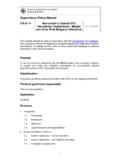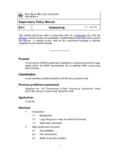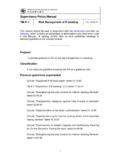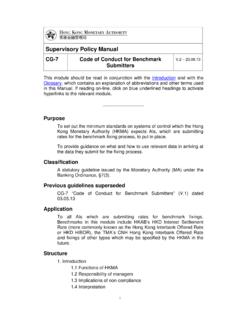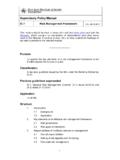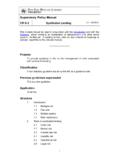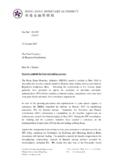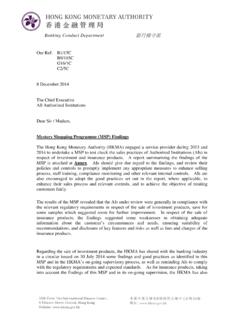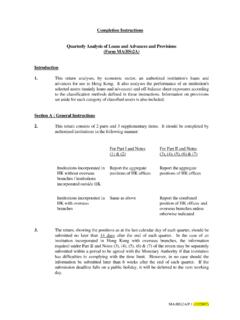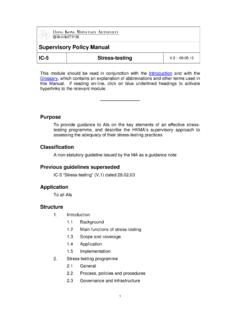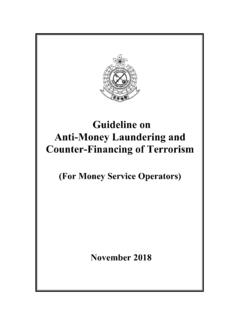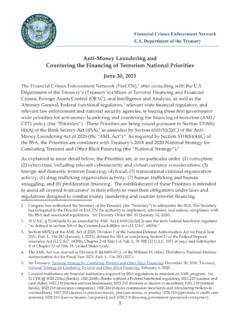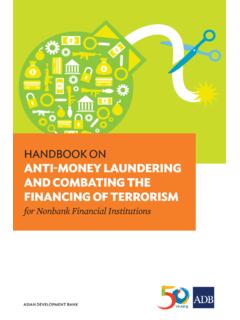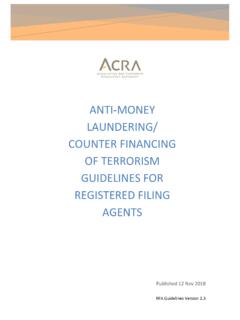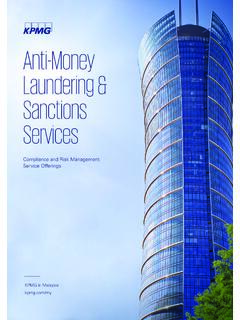Transcription of Frequently Asked Questions in relation to Anti-Money ...
1 1 Last update on 22 October 2021 The Hong Kong Association of Banks Frequently Asked Questions in relation to Anti-Money laundering and counter - financing of Terrorism These Frequently Asked Questions (FAQs) in relation to Anti-Money laundering and counter - financing of Terrorism (AML/CFT) have been developed by the Hong Kong Association of Banks (HKAB) with input from the Hong Kong Monetary Authority (HKMA). This document does not form part of the Guideline on Anti-Money laundering and counter - financing of Terrorism (For Authorized Institutions) (AML/CFT Guideline) and it is designed to be read in conjunction with the AML/CFT Guideline. Terms and acronyms used in this document have the same meanings as in the glossary to the AML/CFT Guideline. These FAQs aim to assist Authorized Institutions (AIs) regulated by the HKMA in understanding relevant AML/CFT requirements.
2 AIs are expected to be fully conversant with these FAQs, and to have regard to them in meeting their AML/CFT legal and regulatory obligations. These FAQs are, however, by their nature framed as general statements and do not take into account the particular circumstances of an AI. AIs should therefore consider the money laundering and terrorist financing risks to which they are exposed and their own circumstances (among others) before taking action on matters to which these FAQs may be relevant. These FAQs should not be regarded as a substitute for obtaining legal or other professional advice on AML/CFT requirements. This document will be kept under review and updated from time to time as necessary. Note: This new set of FAQs will supersede the version issued on 24 May 2021. 2 Last update on 22 October 2021 Relevant provisions Question Answer AML/CFT Systems 1.
3 Paragraph of the AML/CFT Guideline Trigger events for an updated IRA What is regarded as a trigger event for the purpose of determining when an AI should undertake a review of its institutional ML/TF risk assessment? An AI should conduct its institutional ML/TF risk assessment every two years and when material trigger events occur. Non-exhaustive examples of such trigger events may include when: (a) there is a significant breach of the AI s AML/CFT Systems detected; or (b) one of the following has occurred and the AI has assessed that it will materially impact upon its assessment of the institutional ML/TF risks to which it is exposed: 1. the AI acquires a new customer segment or delivery channel; 2. the AI launches new products or services; or 3. there is a significant change of operational processes (eg use of new technology).
4 2. Paragraph and the AML/CFT Guideline Simplified and enhanced AML/CFT Systems Paragraphs and of the AML/CFT Guideline state that AML/CFT Systems can be simplified or enhanced, what does this mean? These two paragraphs refer to enhancing or simplifying the AML/CFT policies, procedures and controls (ie AML/CFT Systems), as distinct from EDD or SDD measures articulated in Chapter 4. They set out the basis for an AI to adopt a risk-based approach in its overall AML/CFT Systems across the institution. The application of these two paragraphs should be based on the AI s institutional ML/TF risk assessment. Depending on how the AI assesses its ML/TF risks, a risk-based approach can be applied on a specific customer segment, a specific line of business, or a specific product or service offered. For example, subject to other criteria set out in paragraphs and , a line of business assessed to have lower ML/TF risks may be subject to less frequent internal audit reviews, less frequent/onerous reporting requirements to senior management, or have simpler AML/CFT procedures etc.
5 3. Paragraph of the AML/CFT Guideline Independent validation Who can independently validate an AI s transaction monitoring systems and processes? Such validation can be performed by an external party or the internal audit function of the AI (see paragraph of the AML/CFT Guideline). 3 Last update on 22 October 2021 Relevant provisions Question Answer Identification and verification of identity natural persons 4. Paragraph of the AML/CFT Guideline Hong Kong residents What documents would be regarded as reliable and independent for verifying the identity information of a natural person customer who is a Hong Kong resident? The following are examples of documents that would be considered to be reliable and independent for Hong Kong residents (both permanent and non-permanent residents). Hong Kong residents aged 12 or above: Hong Kong identity card Children under 12 born in Hong Kong: the child s Hong Kong identity card, birth certificate or valid travel document.
6 In such circumstance an AI should generally regard the minor s parent or guardian as a person acting on behalf of the child and conduct the relevant CDD measures. 5. Paragraph of the AML/CFT Guideline Non-Hong Kong residents What documents would be regarded as reliable and independent for verifying the identity information of a natural person customer who is not a Hong Kong resident? The following are examples of documents that would be considered to be reliable and independent for non-Hong Kong residents: (a) a valid travel document; (b) a national (ie Government or State-issued) identity card bearing the photograph of the natural person; or (c) a valid national (ie Government or State-issued) driving licence incorporating photographic evidence of the identity of the natural person. 6. Paragraph of the AML/CFT Guideline Travel documents What are acceptable travel documents for the purpose of paragraph The following documents are examples of travel documents for the purpose of identity verification: (a) Passport (b) Mainland Travel Permit for Taiwan Residents (c) Seaman s Identity Document (issued under and in accordance with the International Labour Organisation Convention/Seafarers Identity Document Convention 1958) (d) Taiwan Travel Permit for Mainland Residents (e) Permit for residents of Macau issued by Director of Immigration (f) Exit-entry Permit for Travelling to and from Hong Kong and Macau for Official Purposes (g) Exit-entry Permit for Travelling to and from Hong Kong and Macau 4 Last update on 22 October 2021 Relevant provisions Question Answer 7.
7 Paragraph of the AML/CFT Guideline Travel documents What part of the travel documents should be kept on file? An AI should retain a copy of the biodata page of the travel documents, containing the bearer s photograph and biographical details, for the purpose of the record-keeping requirements in the AMLO and the AML/CFT Guideline. 8. Paragraph and of the AML/CFT Guideline British National (Overseas) passport (BN(O)) Can an AI use (BN(O)) passport for identity verification? Reference should be made to the announcement made by the HKSAR Government dated 29 January 2021 ( ) that BN(O) passport would not be recognised as a valid travel document and any form of proof of identity in Hong Kong with effect from 31 January 2021. 9. Paragraph of the AML/CFT Guideline Documents that do not have photographs Can an AI verify the identity of a natural person customer on the basis of a document that does not contain a photograph?
8 This is acceptable only in exceptional circumstances where the customer s associated ML/TF risk has been addressed and mitigated. Exceptional circumstances include where the customer is an asylum seeker who does not have proper identification documents with photographs but has a recognizance form issued by the Hong Kong Immigration Department. If exceptional circumstances apply, an AI may validate a customer s identity with reference to a government-issued document (without a photograph). In such circumstances, additional measures (eg setting appropriate limits to the account; limiting the product and services provided; or conducting enhanced monitoring etc) should be taken to mitigate increased risk. 5 Last update on 22 October 2021 Relevant provisions Question Answer 10. Paragraph of the AML/CFT Guideline Change of name of a natural person customer If a natural person customer s name has changed, what measures should be taken by an AI?
9 If a natural person customer changes their name, an AI should verify the new name by reference to documents, data or information provided by a reliable and independent source following paragraph of the AML/CFT Guideline. To mitigate the risk of impersonation, the AI should corroborate other identification information (eg date of birth, Hong Kong Identity Card number) on the new identification documents against its existing records. In case of doubt, the AI may request a copy of applicable documentation regarding the name change (eg marriage certificate or deed poll). For the avoidance of doubt, if a customer s name has changed before the establishment of a business relationship, only the current name is required to be identified and verified. Identification and verification of identity natural persons (using iAM Smart)1 11.
10 Paragraph and of the AML/CFT Guideline iAM Smart for identity verification Can an AI verify the identity of a natural person using iAM Smart (previously known as "eID")? Yes, iAM Smart can satisfy customer identification and verification requirements under the AMLO. The AMLO permits the use of documents as well as data or information provided by a reliable and independent source, including, where applicable, electronic identification means. There are no restrictions on the form (documentary / physical or digital) that identity evidence documents, information or data can take. iAM Smart is the digital identity developed by the Hong Kong Government. Hong Kong residents can register for iAM Smart using the iAM Smart mobile application. The registration process is in line with the two identity verification principles: identity authentication and identity matching.
